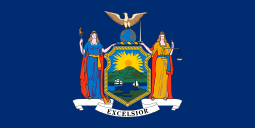Socialist Party of New York
Socialist Party of New York | |
|---|---|
 | |
| Senate leader | None |
| House leader | None |
| Founded | 1973 |
| Headquarters | 339 Lafayette St., New York City, New York |
| Ideology | Democratic socialism |
| National affiliation | Socialist Party USA |
| Colors | Red |
The Socialist Party of New York (SPNY) is the state chapter of the Socialist Party USA (SPUSA) in New York.
History
Socialist Party of America
During its height in the 1910s, the party fielded candidates for the office of Mayor,[1] seats in the New York State Assembly and the House of Representatives.[2] In 1917, several anti-war organizations along with SPNY gathered to discuss the War in Europe.[3] When they nominated Morris Hillquit for Mayor, the party was afraid he along with other members faced imprisonment because of the party's anti-conscriptionist platform. During the national convention for the SPNY of 1917, the party decided to create a party bureau which would support socialist agitators who faced jail time or where sent behind bars.[4] During the national convention in 1918, they discussed the crisis in Russia and the election strategy for the gubernatorial election which was held later in 1918.[5]
In 1920, Samuel Orr, Louis Waldman, Charles Solomon, Samuel DeWitt, and August Claessens were called before the Speaker of the New York State Assembly. The five were charged with being unfit for membership in the Assembly through their membership in the Socialist Party of America and its state affiliate, and were suspended from their seats by a vote of 140 supporting to 6 against suspension.[6] A protracted political trial followed as to the fitness of the five Socialists to assume their seats, which ran throughout the winter and spring. The trial began on January 20, 1920.[7]
Socialist Party USA
The party is affiliated with the Socialist Party USA. It has a close relationship with the Green Party; as such, the Socialist Party almost never seeks ballot access, instead endorsing Green Party candidates.
At the SPA's 1972 National Convention, which was held in Manhattan,[8] the SPA changed its name to "Social Democrats, USA" by a vote of 73 to 34.[9] During the convention, the majority won every vote, by a ratio of two to one. The Convention elected a national committee of 33 members, with 22 seats for the majority caucus, 8 seats for the coalition caucus of Michael Harrington, 2 for the Debs caucus, and one for the "independent" Samuel H. Friedman.[10] Many former members of the Debs caucus joined David McReynolds in founding the Socialist Party of the United States of America in 1973.
Presidential nominee results
In 1956, Darlington Hoopes ran as the final nominee of the Socialist Party of America but was not on the New York ballot. In 1976, following a split in the Socialist Party, Socialist Party USA began running independent candidates with the Socialist Party label. However, no SPUSA presidential nominee has appeared on the ballot in New York.
| Year | Nominee | Total Votes | Percent | Notes |
|---|---|---|---|---|
| 1900 | Eugene V. Debs | 12,869 | 0.83% | Social Democratic Party of America nominee |
| 1904 | Eugene V. Debs | 36,883 | 2.28% | |
| 1908 | Eugene V. Debs | 38,451 | 2.35% | |
| 1912 | Eugene V. Debs | 63,434 | 3.99% | |
| 1916 | Allan L. Benson | 45,944 | 2.69% | |
| 1920 | Eugene V. Debs | 203,201 | 7.01% | |
| 1924 | Robert M. La Follette Sr. | 268,510 | 8.23% | Dual endorsed Progressive Party nominee |
| 1928 | Norman Thomas | 107,332 | 2.44% | |
| 1932 | Norman Thomas | 177,397 | 3.78% | |
| 1936 | Norman Thomas | 86,897 | 1.55% | |
| 1940 | Norman Thomas | 18,950 | 0.30% | |
| 1944 | Norman Thomas | 10,553 | 0.17% | |
| 1948 | Norman Thomas | 40,879 | 0.66% | |
| 1952 | Darlington Hoopes | 2,664 | 0.04% | |
Footnotes
- ↑ "Socialists Fling at all the Parties" (PDF). The New York Times. October 13, 1913. Retrieved February 27, 2010.
- ↑ "Sulzer Appeal Under Way?" (PDF). The New York Times. October 26, 1913. Retrieved February 27, 2010.
- ↑ "Pacifist Demand War Referendum" (PDF). The New York Times. February 5, 1917. Retrieved February 27, 2010.
- ↑ "Socialist Expect Trouble for Ticket". The New York Times. July 9, 1917. Retrieved February 27, 2010.
- ↑ "Socialist Count on Anti-War Voters" (PDF). The New York Times. June 30, 1918. Retrieved February 27, 2010.
- ↑ Journal of the Assembly of the State of New York, Volum 4. University of Michigan. 1920. pp. 33–55. Retrieved February 27, 2010.
- ↑ Waldman, Louis (1920). Albany: The Crisis in Government. Boni & Liveright, New York. p. 50. Retrieved February 27, 2010.
- ↑ Anonymous (27 December 1972). "Young Socialists open parley; to weigh 'New Politics' split". New York Times. p. 25.
- ↑
- Anonymous (31 December 1972). "Socialist Party now the Social Democrats, U.S.A.". New York Times. p. 36. Retrieved February 8, 2010.
- Johnston, Laurie (31 December 1972). "Young Socialists support Meany; Group urges the Democrats to join labor movement". New York Times. p. 36.
- Johnston, Laurie (28 December 1972). "Young Socialists defeat motion favoring recognition of Cuba". New York Times. p. 15.
- ↑ Anonymous (1 January 1973). "'Firmness' urged on Communists: Social Democrats reach end of U.S. Convention here". New York Times. p. 11.
Further reading
- Robert Wark, "Historical Sketch of The New Age, Founded, June 1912: 10 Years of Struggle for the Emancipation of the Masses," The New Age, vol. 11, whole no. 516 (July 13, 1922), pp. 1, 10. —History of the Socialist movement in the city of Buffalo.
